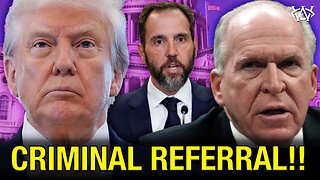Premium Only Content

The Return of the Gold Standard
April 12, 1866, nearly one year to the day of Lincoln’s assassination, Congress went to work at the bidding of the European central-banking interests. It passed the Contraction Act, authorizing the Secretary of the Treasury to begin to retire the Greenbacks in circulation and to contract the money supply.
Authors Theodore R. Thoren and Richard F. Warner explained the results of the money contraction in their classic book on the subject, “The Truth in Money Book”:
“The hard times which occurred after the Civil War could have been avoided if the Greenback legislation had continued as President Lincoln had intended. Instead, there were a series of ‘money panics’ – what we call ‘recessions’ which put pressure on Congress to enact legislation to place the banking system under centralized control. Eventually the Federal Reserve Act was passed on December 23, 1913.”
In other words, the Money Changers wanted two things: 1) the re-institution of a central bank under their exclusive control, and, 2) an American currency backed by their gold.
Their strategy was two-fold: first of all, to cause a series of panics to try to convince the American people that only centralized control of the money supply could provide economic stability; and secondly, to remove so much money from the system that most Americans would be so desperately poor that they either wouldn’t care or would be too weak to oppose the bankers
-
 7:55
7:55
Colion Noir
3 hours agoArmed Woman Drags Gunman Out of Store Before Firing Two Shots
11.7K9 -
 1:24:00
1:24:00
Kim Iversen
3 hours agoFrom The Grave: Virginia Giuffre Names Israeli PM As Her Epstein Abuser
47.9K104 -
 1:02:46
1:02:46
TheCrucible
3 hours agoThe Extravaganza! EP: 57 with Guest Co-Host: Rob Noerr (10/21/25)
56.7K8 -
 DVR
DVR
Redacted News
3 hours agoHIGH ALERT! TRUMP'S WAR WITH VENEZUELA IS COMING, BLACKROCK TAKES OVER ELECTRIC GRIDS
124K64 -
 LIVE
LIVE
Robert Gouveia
2 hours agoEx-CIA Brennan's Criminal Referral!! Jack Smith Caught AGAIN! Judge BLOCKS ICE Arrests!
1,224 watching -
 14:51
14:51
Rethinking the Dollar
8 hours agoSilver Price Crash? Why You’re Still Paying $60+ for Eagles
4.82K10 -
 LIVE
LIVE
The Amber May Show
3 hours agoSlacker82Alpha| SPECIAL GUEST RENOWNED UFO EXPERT STAN DEYO
115 watching -
 LIVE
LIVE
MattMorseTV
4 hours ago $5.32 earned🔴Community Hangout🔴
429 watching -
 LIVE
LIVE
Tundra Tactical
5 hours ago $2.52 earnedThe Great Tundra Nation Gaming Stream!!! Featuring ThePiggNation LAST DAY!!!!
90 watching -
 2:38:50
2:38:50
The Rabble Wrangler
4 hours agoThe Best in the West | Live From Rumble Studios
23.8K